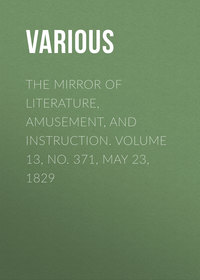Kitabı oku: «The Mirror of Literature, Amusement, and Instruction. Volume 13, No. 371, May 23, 1829», sayfa 4
Various
Bir şeyler ters gitti, lütfen daha sonra tekrar deneyin
Türler ve etiketler
Yaş sınırı:
0+Litres'teki yayın tarihi:
31 ekim 2018Hacim:
51 s. 3 illüstrasyonTelif hakkı:
Public Domain